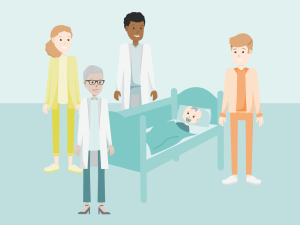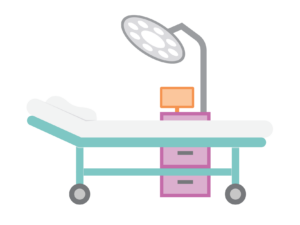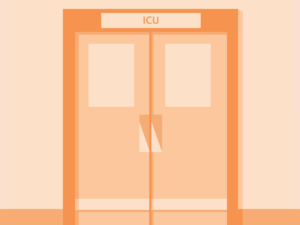
Navigating such a big and important surgery can feel overwhelming. There are many people and resources available to help you get through your surgery journey and ultimately get you living a more comfortable and healthy life. You can also prepare by reading and learning as much as you can before heading into surgery.
-
Preparing
for Surgery -
After Surgery
-
Recovery
Preparing for Surgery
 Throughout your journey, your care team is there to support and guide you, as well as answer any questions or concerns you have.
Throughout your journey, your care team is there to support and guide you, as well as answer any questions or concerns you have.
Before your surgery, doctors called anesthesiologists will visit you. They are responsible for keeping you asleep during surgery. You will not feel any pain while you are asleep. All you will remember is traveling down to the operating room.
Your Surgery Day
The surgeon performs a sternotomy which involved opening your chest and implanting the cannulae into your heart. This will leave a scar on your chest. During the surgery, you will be on a heart and lung bypass machine, which helps circulate your blood during the operation.
After the VAD is turned on, the settings are adjusted to provide the correct blood flow to your body.
After Surgery
 When you wake up from surgery, you will be in the Intensive Care Unit (ICU).
When you wake up from surgery, you will be in the Intensive Care Unit (ICU).
Surgery will make you feel weak and sleepy. For these reasons, you will have a plastic tube in your mouth that will help you breathe. You will also have many special IVs, cables, and drains, which are needed to monitor your VAD and heart function.
This medical equipment is necessary to monitor you and give you the medicines needed for recovery. All the equipment and lines can be startling to see, but they are completely normal. Day by day, your care team will work toward removing lines and tubes. It is also important to get you moving soon after surgery. Getting out of bed as soon as possible will help your body heal.
As with any surgery, you will probably feel some pain afterwards. Once your care team thinks you’re strong enough to be more awake and breathe on your own, your medicines keeping you sleepy will be turned off. Your breathing tube will be removed, and you will be given oxygen using a nasal cannula or mask. Your care team may also decide to give you a boost of nutrition, feeding you through a special tube in your nose called a nasogastric tube.
Recovery Self Care
When your breathing tube is out and you’re fully awake, this is when rehabilitation begins. Specially trained physical and occupational therapists will assist you in getting out of bed for the first time after surgery. Your care team will be there to support you every step of the way.
Your cannula sites will need to have dressing changes using sterile technique. Your care team will use sterile gloves and wear masks during dressing changes. How often your dressings are changed will be determined by your care team.
Recovery is a slow and steady process. Everyday you will gain more strength and your care team will help you make decisions for the next steps in your journey.
Preparing for Surgery
 Throughout your journey, your care team is there to support and guide you, as well as answer any questions or concerns you have.
Throughout your journey, your care team is there to support and guide you, as well as answer any questions or concerns you have.
Before your surgery, doctors called anesthesiologists will visit you. They are responsible for keeping you asleep during surgery. You will not feel any pain while you are asleep. All you will remember is traveling down to the operating room.
Your Surgery Day
The surgeon performs a sternotomy which involved opening your chest and implanting the cannulae into your heart. This will leave a scar on your chest. During the surgery, you will be on a heart and lung bypass machine, which helps circulate your blood during the operation.
After the VAD is turned on, the settings are adjusted to provide the correct blood flow to your body.
After Surgery
 When you wake up from surgery, you will be in the Intensive Care Unit (ICU).
When you wake up from surgery, you will be in the Intensive Care Unit (ICU).
Surgery will make you feel weak and sleepy. For these reasons, you will have a plastic tube in your mouth that will help you breathe. You will also have many special IVs, cables, and drains, which are needed to monitor your VAD and heart function.
This medical equipment is necessary to monitor you and give you the medicines needed for recovery. All the equipment and lines can be startling to see, but they are completely normal. Day by day, your care team will work toward removing lines and tubes. It is also important to get you moving soon after surgery. Getting out of bed as soon as possible will help your body heal.
As with any surgery, you will probably feel some pain afterwards. Once your care team thinks you’re strong enough to be more awake and breathe on your own, your medicines keeping you sleepy will be turned off. Your breathing tube will be removed, and you will be given oxygen using a nasal cannula or mask. Your care team may also decide to give you a boost of nutrition, feeding you through a special tube in your nose called a nasogastric tube.
Recovery Self Care
When your breathing tube is out and you’re fully awake, this is when rehabilitation begins. Specially trained physical and occupational therapists will assist you in getting out of bed for the first time after surgery. Your care team will be there to support you every step of the way.
Your cannula sites will need to have dressing changes using sterile technique. Your care team will use sterile gloves and wear masks during dressing changes. How often your dressings are changed will be determined by your care team.
Recovery is a slow and steady process. Everyday you will gain more strength and your care team will help you make decisions for the next steps in your journey.